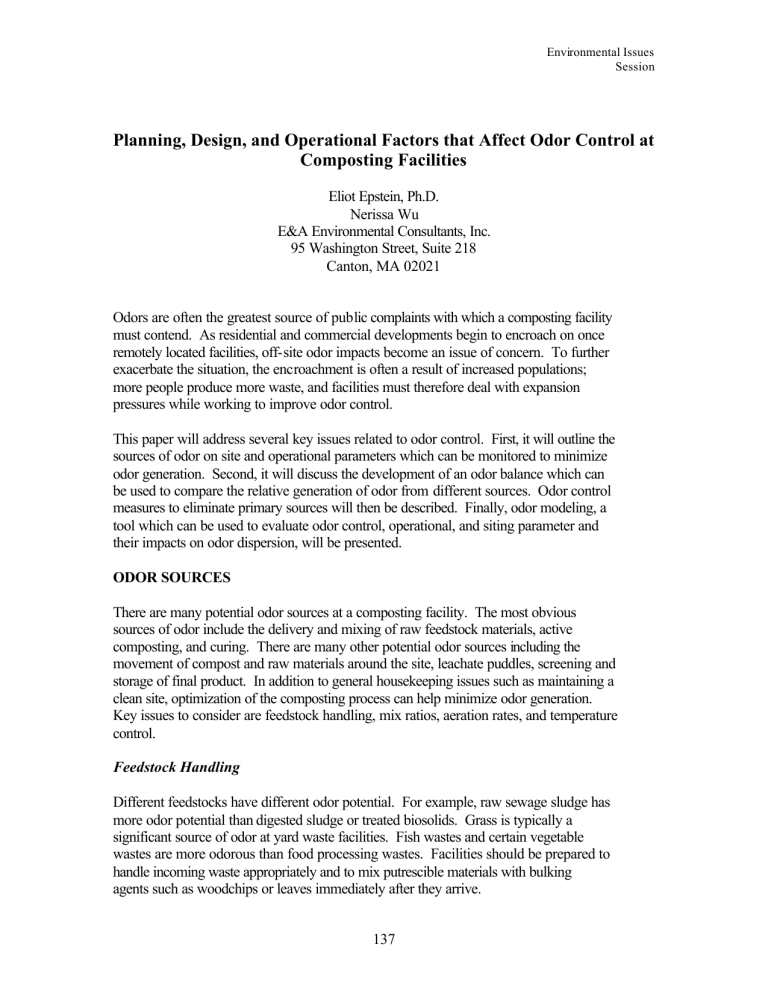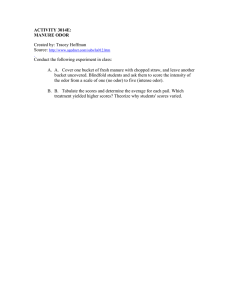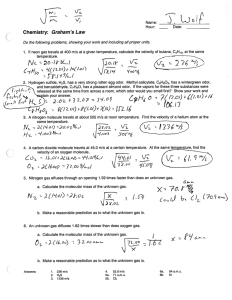
Environmental Issues Session Planning, Design, and Operational Factors that Affect Odor Control at Composting Facilities Eliot Epstein, Ph.D. Nerissa Wu E&A Environmental Consultants, Inc. 95 Washington Street, Suite 218 Canton, MA 02021 Odors are often the greatest source of public complaints with which a composting facility must contend. As residential and commercial developments begin to encroach on once remotely located facilities, off-site odor impacts become an issue of concern. To further exacerbate the situation, the encroachment is often a result of increased populations; more people produce more waste, and facilities must therefore deal with expansion pressures while working to improve odor control. This paper will address several key issues related to odor control. First, it will outline the sources of odor on site and operational parameters which can be monitored to minimize odor generation. Second, it will discuss the development of an odor balance which can be used to compare the relative generation of odor from different sources. Odor control measures to eliminate primary sources will then be described. Finally, odor modeling, a tool which can be used to evaluate odor control, operational, and siting parameter and their impacts on odor dispersion, will be presented. ODOR SOURCES There are many potential odor sources at a composting facility. The most obvious sources of odor include the delivery and mixing of raw feedstock materials, active composting, and curing. There are many other potential odor sources including the movement of compost and raw materials around the site, leachate puddles, screening and storage of final product. In addition to general housekeeping issues such as maintaining a clean site, optimization of the composting process can help minimize odor generation. Key issues to consider are feedstock handling, mix ratios, aeration rates, and temperature control. Feedstock Handling Different feedstocks have different odor potential. For example, raw sewage sludge has more odor potential than digested sludge or treated biosolids. Grass is typically a significant source of odor at yard waste facilities. Fish wastes and certain vegetable wastes are more odorous than food processing wastes. Facilities should be prepared to handle incoming waste appropriately and to mix putrescible materials with bulking agents such as woodchips or leaves immediately after they arrive. 137 Environmental Issues Session Mix Ratios The ratio of materials combined to form the compost feedstock is significant because it determines the moisture content, the pore space, and the carbon to nitrogen (C:N) ratio of the mix. For most composting systems, the initial solids content of the compost mix should be at least 40 percent (less than 60 percent moisture). Excess moisture reduces pore space and impedes the even flow of air through the composting material resulting in anaerobic pockets. Insufficient moisture inhibits the microbial composting activity, slowing degradation. The C:N ratio of a composting mix should be approximately 30:1. A lower ratio (excess nitrogen) results in the loss of ammonia which may lead to odor problems. A mix with a higher C:N ratio may have insufficient nitrogen for optimum microbial degradation of carbon, and composting will be slowed. Aeration Rates Aeration is one of the most important elements of a composting system because oxygen is essential to microbial activity. Although both aerobic and anaerobic degradation can result in odors, more odorous compounds are generated under anaerobic conditions than aerobic conditions. Compost piles are aerated by agitation, in the case of windrow systems, forced aeration operated by mechanical blowers, in the case of aerated static piles, and by both forced aeration and agitation in many in-vessel systems. The aeration system must be carefully sized to provide enough air to composting microbes without excessively removing heat and moisture from the pile. Moisture content and pore size are important elements to a proper aeration system; excess moisture or overly dense material will impede aeration and increases the potential for odor generation. Temperature Temperature control of composting piles through the adjustment of aeration rates is also an important operational parameter. There is conflicting data regarding the effect of high temperatures on odor generation. Higher temperatures typically result in increased odor generation; odor character and strength of compounds formed at higher temperatures is quite discernable even at large distances. However, if material composts at higher temperatures, less air is used to cool the pile, and therefore, the volume of emissions is lower. Total odor generation is a function of both odor concentration and the volume of emissions from a pile; the overall effect of higher pile temperatures is not clear. However, it is certain that maintaining uniform temperatures throughout piles and optimizing the rate of composting will help to minimize odor generation. DEVELOPING AN ODOR BALANCE Although operational changes can help to minimize odors, many well-run facilities encounter odor problems because of the proximity of their neighbors. Before odor control work is undertaken, an odor balance should be developed to determine what the primary odor sources are. An odor balance is tally of the total number of odor units 138 Environmental Issues Session generated by specific odor sources. The total number of odor units is a function of the concentration of odor, expressed in dilutions to threshold or odor units per cubic meter, the total emissions rate from a source, and the duration of odor generation. The odor balance can help to prioritize odor control actions by determining which sources contribute the largest percentage of odor units. Odor Sampling and Measurement Odor sampling methodology is similar to sampling for any air contaminants. Samples are captured from pile or biofilter surfaces, or from plumes generated from volume or point sources and sealed in Tedlar bags. Bags are then shipped to laboratories for odor analysis. Odor concentration is determined by odor panel analysis. An odor panel is a group of eight or more trained individuals who are presented with an odor at decreasing levels of dilution (increasing concentration). The panelists are concurrently presented with nonodorous air at additional sniff ports and asked to identify the sample which contains the odorous air. The point at which one-half of the panel members can detect which sample contains the odorous air is considered the dilution threshold, or the number of volumes of fresh air needed to dilute a volume of odorous air in order to render it undetectable. The dilution threshold, expressed as dilutions to threshold (D/T) or ED50 , is also expressed in terms of odor units per unit volume of air. Since the number of odor units generated by a particular source is a function both of the odor concentration (odor units per volume air) and the volume of air generated by a source, flow rates from piles, biofilters, or other odor sources are also measured. These measurements are used to formulate an odor balance. Odor panels also analyze odor for intensity. Odor intensity measures the sharpness or the potential to cause odor impacts of a particular odor. A high intensity odor would create odor impacts even at low concentration while a low intensity odor could be present in relatively high concentrations before causing nuisance conditions. Odor intensity is measured by comparing an odor sample at different concentrations to a standard scale of intensity. A dose-response curve is thereby created which can be used to determine the concentration at which a particular odor will cause odor impacts. Table 1 is an example of an odor balance that was constructed for a windrow composting facility. The second column shows the concentration of odor emissions from specific sources. The third column shows the number of hours each day that each source is active. The flux rate, or the volume of odorous air generated per square meter of surface area per unit time is not listed in the table but is used to calculate the total number of odor units generated per day, listed in the fourth column. As shown, 27 percent of the odors were generated by composting windrows and 62 percent of odors were generated by curing piles. Although turning was generating the 139 Environmental Issues Session strongest concentration of odors, the short duration of turning, as compared with the constant surface area source of large curing piles, actually resulted in fewer odor units overall. An odor balance is a good preliminary indication of what the primary odor sources on a site are; odor mitigation measures can therefore be designed for maximum effectiveness. It should be noted however that odor dispersion from a site is not simply a matter of the number of odor units generated; there are many parameters to consider including source dimensions, topography, and the hours of emissions. Odor balances also do not take odor intensity into account; for example, while new compost piles may not produce the highest number of odor units, the intensity of the odor generated may be higher because of the types of compounds formed during the early stages of composting. Higher intensity odors are detectable at lower concentration and therefore have a relatively higher potential to cause odor impacts. Table 1 – Odor Balance – Windrow Composting Facility Source Odor Duration Concentration (hours/day) Feedstock Delivery and Storage Feedstock delivery Feedstock storage Feedstock transfer Feedstock Mixing Mixing Mix pile storage Mix pile transfer Composting Pile construction Surface (1-5 days) Turning (1-5 days) Surface (6-10 days) Turning (6-10 days) Surface (11-20 days) Turning (11-20 days) Surface (21-28 days) Turning (21-28 days) Pile tear down Curing Surface (1-7 days) Surface (8-28 days) Surface (29-70 days) Pile tear down Post-Processing Screening Storage Transfer Standing Water Compost runoff Curing runoff Agitated curing runoff Total Total Emissions (103 odor units/day) Percentage 1.0 200 386 82 8 24 8 77 14,895 26 1500 386 82 8 24 8 468 14,895 26 82 1370 5460 1500 7080 23 5000 89 3000 82 8 24 0.8 24 0.8 24 0.8 24 0.8 8 26 169,174 10,319 185,227 13,381 2,840 12,600 10,990 7,560 26 7080 7080 177 7080 24 24 24 8 455,350 455,350 22,767 2,209 1000 1000 1000 8 24 8 312 115,767 312 149 149 12800 24 24 24 3,833 17,249 3,994 1,519,672 1.0 27.1 61.6 7.7 1.7 140 Environmental Issues Session ODOR MITIGATION There are several means to mitigate site odor. These include counteractants and masking agents which are sprayed over a site or specific odor sources, chemical scrubbers which adsorb or oxidize odorous gases by passing emissions through scrubbant solutions, and biofilters which utilize natural microbial activity to break down odorous compounds. Counteractants and Masking Agents Both counteractants and masking agents are typically applied through a fine-mist spray system. The mist can be sprayed directly over odor sources, or mist may be sprayed from points along the perimeter to prevent odor from moving off-site. Masking agents are designed to cover up odors while counteractants are meant to react with odorous compounds and alter their character and intensity. In both cases, the effectiveness depends in large part on ensuring contact between odorous compounds and the spray particles. In general, they have not been very successful at composting facilities. Chemical Scrubbers Chemical scrubber systems pass scrubbant solutions through the emissions air stream to remove odorous gases by adsorption or oxidation. Scrubbers are typically best suited to low-volume, high-concentration odorous exhaust air, so they are not always appropriate for composting facilities which generate a large volume of exhaust. In addition, since compost exhaust typically contains multiple odor-causing compounds, multi-stage scrubber systems are often required for effective odor control. The use of scrubbers requires chemical handling and storage, and scrubbers can be expensive to maintain because of the cost of the chemical agents. Biofilters Biofilters use the naturally occurring microbial populations within a solid media matrix to adsorb and biologically degrade odorous air pollutants. Biofilter media typically consists of compost, bark, woodchips, soil, sand, or a mixture of these and other materials. Biofilter design often includes a humidification system which moistens exhaust air as it moves from the composting process to the biofilter plenum. The stone plenum and a system of aeration piping distribute the exhaust air evenly throughout the biofilter media which removes a wide range of odorous compounds as they pass through. The advantage of biofiltration is that the biological system can remove multiple compounds at low operating cost. The primary disadvantage of biofilters is that they require a relatively large area. The success of any odor control system depends on the ability of the system to capture a high percentage of odorous emissions generated and the effectiveness of odor treatment. However, the potential for off-site odor impacts also depends on the dispersion patterns from an odor source. Dispersion is dependent on source parameters such as height and 141 Environmental Issues Session velocity, local topography, and meteorology. Odor models can be used to determine the direction of dispersion and the potential for off-site odor impacts. ODOR MODELING Air dispersion modeling can be used to evaluate the movement of odor from a source and determine the extent and frequency of odor impacts on a surrounding community. Models are often used as part of the permitting process to determine if a proposed facility will create odor nuisance conditions. Models are also used by existing facilities to evaluate proposed expansions or operational modifications. For example, a model can be used to compare different odor control scenarios so that the most cost-effective solution can be identified. The model that is typically used for composting facilities is the EPA-recommended ISCST3 model. This model takes local topographical and meteorological data into account and combines this information with emissions concentrations, site layout, operational parameters, and source dimensions to determine the movement of odors from the source. The results are expressed as a series of isopleths, concentric circles which are drawn based on the maximum odor concentration projected to occur at points surrounding the facility. An example of modeling results is shown in Figure 1. As shown, the source of odors is an open biofilter in the southwest corner of a facility. Odor dispersion isopleths show that off-site odor concentrations will range from 5-8 D/T along Highway 101 to 3-5 D/T in the residential development to the west. Points along the border of the site are projected to experience concentrations in the range of 5-13 D/T. As discussed above, the concentration at which a particular odor creates nuisance conditions depends on the intensity of that specific odor. Odor analysis data from various composting operations has shown that compost odors typically constitute a nuisance condition at 5 D/T. Based on this nuisance threshold of 5 D/T, all points on Figure 1 which fall within the 5 D/T isopleth are projected to experience at least one 10-minute odor nuisance condition under the meteorological conditions modeled (typically 1-5 years of meteorological data are used). The results of this model were unacceptable to the residents of the community as many of their homes, the school, and the local state park were projected to experience odor impacts. The model was therefore run with an enclosed biofilter with two roof vents. Although in this scenario, the same number of odor units were still being emitted from the biofilter surface, enclosing the biofilter improved odor dispersion by several means. First, since an enclosed biofilter must be sufficiently tall to allow a front-end loader access to the media, the roof vents were at a much higher height than the open biofilter. The vents also released air at a higher velocity than the open biofilter. Both added velocity and height increase the rate at which exhaust air will mix with ambient air, increasing dispersion. In addition, make-up air added to the biofilter exhaust to boost biofilter emissions through the vents diluted the emissions before they were released. 142 Environmental Issues Session The resulting model output is shown in Figure 2. As shown, enclosing the biofilter greatly reduced the range of odor impacts, but there were still some off-site impacts projected. The biofilter scenario was therefore run a third time; for the third scenario, an additional 10 percent make-up air was added to the exhaust, and the number of roof vents was increased to four. As shown in Figure 3, the result for this scenario was a complete elimination of off-site odor impacts. The model can be used to project the number of odor impacts at a particular receptor point and to determine the conditions under which impacts are likely to take place. A facility can then use this information to select the best odor control option. For example, in the case of Scenario 2, if odor impacts were found to occur off-site only during late night hours, or only during winter weather conditions, a community might be satisfied with this odor control option. Other communities might have a zero-tolerance policy and would not accept any odor impacts, regardless of the cost of mitigation. The model allows a facility to examine options and their effectiveness before investing in site equipment or construction. 143 Environmental Issues Session 144 Environmental Issues Session 145 Environmental Issues Session 146



